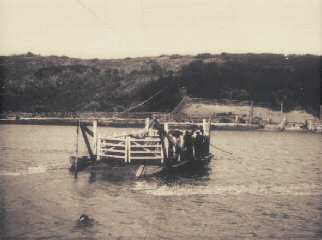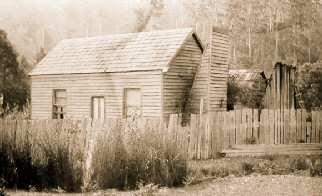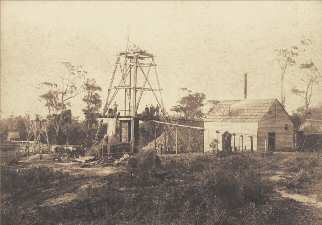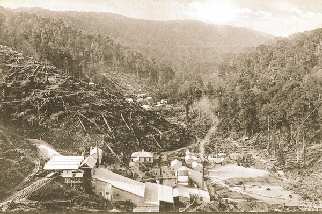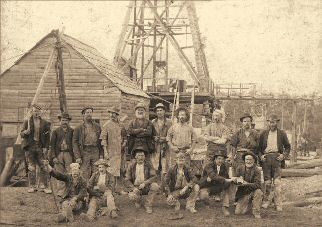If you would like to find out more, please go
DESCRIPTIVE TIMELINE OF THE TASMANIAN GOLD RUSH
FIRST DISCOVERY
Gold was believed to have been discovered on the apple isle at Nine Mile Springs (called "The Den", near Lefroy 1881) in northern Tasmania (NE) in 1840 by a convict. Then it is said that John Gardner found gold-bearing quartz in 1847 on Blythe Creek, near Beaconsfield. But the first substantiated find was made by a Mr Riva in that area in 1849. Gold was first found at Tullochgorum (see Nook below) near Fingal in north eastern Tasmania in 1851 by the "Old Major" who quietly worked the gully for several years. A Major's Gully exists at Mangana.
Officially, the first payable alluvial deposits were reported in 1852 by James Grant at the Nook (NE) (later called Mangana) and Tower Hill Creek (NE). (Debate ensues as to whether Mangana, the Nook and Tullochgoram were one and the same place.) Note though that the first registered gold strike was made by Charles Gould in 1852. It was located at Tullochgoram (E) near Fingal, south of St. Marys and weighed 2lb 6ozs.
In 1854 gold came to light at Mt. Mary (SE).
Tasmania's first reef gold mine was opened by James Grant in 1856 at the Nook (N). The discovery attracted 500 new miners.
The first payable reef gold was found at Mangana (NE) and Mathinna in 1858.
In 1859 a new discovery was made by James Smith who came upon it at River Forth (N), and Peter Leete struck it at Calder nor-north western Tasmania (NNW) a tributary of the Inglis.
In 1862 geologist Charles Gould located small quantities of gold in the King and Franklin Rivers (W) near Macquarie Harbour, and on the Acheron River a tributary of the Jane River.
Charles Gould obtained gold from Lyndhurst (Waterhouse) (NE) in 1864 and 1869.
THE RUSH
At Specimen Hill, Nine Mile Springs (Lefroy) the first alluvial gold was discovered by Samuel Richards in the year I869 (reef gold was actually identified in 1867). Production was mainly restricted to the Native Youth, Chum, Volunteer and New Pinafore Reef mines. The news of this brought the first big rush to Nine Mile Springs. A township quickly developed beside the present main road from Bell Bay to Bridport, and dozens of miners pegged out claims there and at nearby Back Creek. Samuel Richards's Specimen Hill find was alluvial gold. However most of the gold in the Nine Mile Springs area was bonded to quartz below the surface. Consequently, companies moved in to crush the ore. Lefroy Goldfield became the first profitable goldfield.
Gold was initially found at Cabbage Tree Hill (N) in 1870, (later renamed Brandy Creek which became Beaconsfield in 1879) .
The Denison and Golconda (SW) alluvial deposits were not discovered until 1872, and the reefs were not opened up until 1876 and 1877 respectively. Charles Bessel and company also found gold at Tobacco Creek near Golconda Creek in 1877.
Chinese also panned for gold in 1876 at the Hellyer Cam and Inglis Rivers, and at Doctors Rock (NW) a landmark near Wynyard and Somerset. The government surveyor, Charles Sprent led his first expedition. He located alluvial and reef gold in the many creeks running into the Pieman River near Waratah; also in the Whyte and Heazlewood Rivers.
Perhaps the most important gold discovery in Tasmania occurred in 1877, when William and David Dally found an auriferous reef of gold at Tasmania reef on the eastern side of Cabbage Tree Hill (N), Beaconsfield Goldfield (N) in the Tamar Valley (Small quantities of gold were found there earlier in 1857). Major gold companies moved to the region. The crushing of quartz ore began at Mathinna (E) (this was an important mine giving 246,000 ozs of gold from 300,000 tons of ore) and Tower Hill near St. Marys. Gold was detected at Lymington near Cygnet. Beaconsfield in northern Tasmania commenced organized production in 1877 when Mr. William Dally discovered an auriferous reef. In a short space of time, 53 mining companies began operating in the area. This made Beaconsfield the third largest town in Tasmania. Between 1877 and 1914 Beaconsfield, notably the Grubb Shaft Mine sunk in 1879, was by far the largest single source of gold in the state, reaching its peak in gold production around 1900. Beaconsfield gave 855,000 ozs of gold from 1,023,000 tons of ore. The west coast was opened up when gold was found by Jack Brown at a place called Brown Plains (W) in 1877.
Frank Timbs came upon the mineral in 1878 at a location between Heemskirk and Waratah (NW).
The most productive mine in Tasmania was Lisle Creek at Lisle Goldfield (N), (originally Mt. Arthur Goldfield), discovered by Charles Bessell and his brother in 1879, where more than 250,000 ozs of gold was obtained. Within a year, more than 2,500 miners worked the mine. Soon creeks on the Whyte, Savage and Donaldson Rivers (NW) were identified as sources for gold. Other locations were at Long Plains (1 km east of Golden Ridge); and in the Savage River area north of Pieman River including Big Duffer Creek on the southern margin of Golden Ridge opened by George Johnson and Ted Peevor. Extensive alluvial gold deposits, enough for a decent living to about 400 diggers in those days, were found at Middleton Creek in 1879 (NW) by Harry Middleton and company. A gold rush ensued when in 1879 diggers came across gold in the Pieman River Goldfield (Corinna Goldfield) from the Meredith Range to the Donaldson River which included Browns Plains, Nancy Creek, Lucy Creek and Paradise River, all tributaries to the Pieman River south-east of Corinna.
There was a find at Gladstone (NE) in 1880
In 1881 Tom Smith and Harry Howard cam across gold at Smith's creek (Obsidian Creek) (not Smiths Creek near Geeveston), running in the opposite direction to Big Duffer Creek (NW). It was an extremely rich find. The dig produced 450 ozs of gold. Tom Smith dug up 120 ozs of gold in 1881 at Townsend's Creek near Smiths Creek. Broderick and a party of prospectors picked up a gold nugget of 8 3/4 ozs at Grays Creek (not Grays Creek near Smithton), in 1881. Gold was reported by Gustav Thureau in the Sheffield Quadrangle (N) south of the Minnow River in 1881. Samuel Richards received a reward of £3000 in 1881 for his discovery of profitable gold on Specimen Hill near Nine Mile Springs in 1869.
S. Hall, T. Jones, G. Johnson and T. Farrell, located rich gold in a creek west of the Savage River (NW), north of Long Plains (not Long Plains near Launceston) in 1882. A nugget was found there in the same year weighing 9 ozs by messrs Bucker and May. Gold was brought to light in 1882 in a new location at Specimen Creek (later renamed Specimen Reef) at digs called Lucky Hit, Second to None and Goldfinger by G. Thunder and T. Greenway. Being the first gold reef on the West Coast, the workings produced 40 ozs of gold.
Alluvial deposits were brought to light by Cornelius Lynch, T. Curry and S.J. Lenahan at Lynch's Creek on Queen River in Queens River Valley (E) in 1882 (some sources 1881 others 1883). Prospectors moved here from the Pieman River. The first battery on the West Coast was set up by King River Gold Mining Company at Lynch's Reward claim. Crushing of gold-bearing quartz began.
The largest gold nugget ever found in Tasmania weighing over 243 ozs (7.5 kg) was found at Rocky River (NW) near Savage River township (though Corinna township also makes this claim), Golden Ridge about 1km west of Long Plains by J. McGinty, D. Neil, and T. Richards in 1883. It should be noted that more gold was obtained from the surrounding area than the famous Golden Ridge itself. Overall nearly 30,000 ozs of gold was retrieved from this location.
In 1883 fine gold was shed from a thick ironstone mass called Iron Blow at Gormanston Hill (W), in the region later to be Queenstown. It was detected by three men, Bill and Mick McDonough and Steve Karlson in the Linda Valley near Mount Lyell (Central Tasmania). They pegged a claim and traced the auriferous material to the eastern flank of a ridge connecting Mount Lyell to Mount Owen. The "Blow" was worked as a gold mine for ten years. In 1886 F Henry, J Crotty and W Dixon formed the Mount Lyell Gold Mining Company. The site was finally proclaimed in 1886 at Mount Lyell. It produced 512,000 ozs of gold since it was opened. Queenstown was established near this location in 1896. The Linda goldfields near Queenstown (W) was worked from 1883 until about 1890. Queenstown emerged as the world's richest mining town in the 1890s with the discoveries at Mt. Lyell.
In 1883 gold was located nearby at Grays Creek (NW) (not Grays Creek near Smithton) on the flank of Golden Ridge by Weetman and Crockford.
Gold was obtained at Mount Victoria (NE), Alberton, by Mr R. J. Wilson in a creek named after him in (I883). This goldfield is situated on the western flanks of Mount Victoria, or about half-way down from the summit of that mountain to the banks of the Dorset River. Four promising gold-bearing quartz veins were discovered. Branxholm near Mount Victoria gave up gold in 1883.
Sites were explored in creeks on the Garfield River (W) at Mount Strahan. Notably, a Creek produced gold for P. Flanigan in 1885. The creek was named after him. This location between Mt. Jukes and Mt. Strahan was to become a good gold producing region after the turn of the century.
Gold was won from the hills around Port Cygnet (SE) since the late 1800’s. Most of the gold was recovered from the alluvial workings around Lymington by the late 1800s.
Golden Gate at Mathinna, the state's second largest gold mine, was established in 1886.
Alfred Conliffe struck a gold-bearing gossan in 1890 on the western side of Mount Read (W).
The last gold rush occurred in Tasmania in 1891. C. Brooker, J.O. Rooke, G. Kirkland and J. Mills came across gold near Zeehan (W) in a creek on the Ring River at Mt. Hamilton.
Narrawa Creek (N), Moina, was put on the gold map by T. Bessel and C. L. Stewart in 1893. Underground and surface mining has retrieved 1,000 ozs of gold.
Rosebery's economy has thrived to this day from a huge gold mine started by Tom McDonald at Mount Black in 1893. The mine has produced 138,000 ozs of gold.
Gold nuggets weighing as much as 7 1/2 ozs were obtained at Paradise Creek (NW) near Paradise River in 1895.
Gold production peaked in Tasmania in 1899. Alluvial gold output reached 250,000 ounces from the Lisle Goldfield, near Mt. Arthur. Overall, more gold was retrieved from the Lefroy Goldfield which gave alluvial and reef gold, but by the late 1890s the last boom in mining at Lefroy was over. The best mine proved to be Beaconsfield, 854,600 ozs of gold. Over a 50 year period from 1880, 253,865 ozs came from the Golden Gate Mine at Mathinna.
FIRST DISCOVERY
Gold was believed to have been discovered on the apple isle at Nine Mile Springs (called "The Den", near Lefroy 1881) in northern Tasmania (NE) in 1840 by a convict. Then it is said that John Gardner found gold-bearing quartz in 1847 on Blythe Creek, near Beaconsfield. But the first substantiated find was made by a Mr Riva in that area in 1849. Gold was first found at Tullochgorum (see Nook below) near Fingal in north eastern Tasmania in 1851 by the "Old Major" who quietly worked the gully for several years. A Major's Gully exists at Mangana.
Officially, the first payable alluvial deposits were reported in 1852 by James Grant at the Nook (NE) (later called Mangana) and Tower Hill Creek (NE). (Debate ensues as to whether Mangana, the Nook and Tullochgoram were one and the same place.) Note though that the first registered gold strike was made by Charles Gould in 1852. It was located at Tullochgoram (E) near Fingal, south of St. Marys and weighed 2lb 6ozs.
In 1854 gold came to light at Mt. Mary (SE).
Tasmania's first reef gold mine was opened by James Grant in 1856 at the Nook (N). The discovery attracted 500 new miners.
The first payable reef gold was found at Mangana (NE) and Mathinna in 1858.
In 1859 a new discovery was made by James Smith who came upon it at River Forth (N), and Peter Leete struck it at Calder nor-north western Tasmania (NNW) a tributary of the Inglis.
In 1862 geologist Charles Gould located small quantities of gold in the King and Franklin Rivers (W) near Macquarie Harbour, and on the Acheron River a tributary of the Jane River.
Charles Gould obtained gold from Lyndhurst (Waterhouse) (NE) in 1864 and 1869.
THE RUSH
At Specimen Hill, Nine Mile Springs (Lefroy) the first alluvial gold was discovered by Samuel Richards in the year I869 (reef gold was actually identified in 1867). Production was mainly restricted to the Native Youth, Chum, Volunteer and New Pinafore Reef mines. The news of this brought the first big rush to Nine Mile Springs. A township quickly developed beside the present main road from Bell Bay to Bridport, and dozens of miners pegged out claims there and at nearby Back Creek. Samuel Richards's Specimen Hill find was alluvial gold. However most of the gold in the Nine Mile Springs area was bonded to quartz below the surface. Consequently, companies moved in to crush the ore. Lefroy Goldfield became the first profitable goldfield.
Gold was initially found at Cabbage Tree Hill (N) in 1870, (later renamed Brandy Creek which became Beaconsfield in 1879) .
The Denison and Golconda (SW) alluvial deposits were not discovered until 1872, and the reefs were not opened up until 1876 and 1877 respectively. Charles Bessel and company also found gold at Tobacco Creek near Golconda Creek in 1877.
Chinese also panned for gold in 1876 at the Hellyer Cam and Inglis Rivers, and at Doctors Rock (NW) a landmark near Wynyard and Somerset. The government surveyor, Charles Sprent led his first expedition. He located alluvial and reef gold in the many creeks running into the Pieman River near Waratah; also in the Whyte and Heazlewood Rivers.
Perhaps the most important gold discovery in Tasmania occurred in 1877, when William and David Dally found an auriferous reef of gold at Tasmania reef on the eastern side of Cabbage Tree Hill (N), Beaconsfield Goldfield (N) in the Tamar Valley (Small quantities of gold were found there earlier in 1857). Major gold companies moved to the region. The crushing of quartz ore began at Mathinna (E) (this was an important mine giving 246,000 ozs of gold from 300,000 tons of ore) and Tower Hill near St. Marys. Gold was detected at Lymington near Cygnet. Beaconsfield in northern Tasmania commenced organized production in 1877 when Mr. William Dally discovered an auriferous reef. In a short space of time, 53 mining companies began operating in the area. This made Beaconsfield the third largest town in Tasmania. Between 1877 and 1914 Beaconsfield, notably the Grubb Shaft Mine sunk in 1879, was by far the largest single source of gold in the state, reaching its peak in gold production around 1900. Beaconsfield gave 855,000 ozs of gold from 1,023,000 tons of ore. The west coast was opened up when gold was found by Jack Brown at a place called Brown Plains (W) in 1877.
Frank Timbs came upon the mineral in 1878 at a location between Heemskirk and Waratah (NW).
The most productive mine in Tasmania was Lisle Creek at Lisle Goldfield (N), (originally Mt. Arthur Goldfield), discovered by Charles Bessell and his brother in 1879, where more than 250,000 ozs of gold was obtained. Within a year, more than 2,500 miners worked the mine. Soon creeks on the Whyte, Savage and Donaldson Rivers (NW) were identified as sources for gold. Other locations were at Long Plains (1 km east of Golden Ridge); and in the Savage River area north of Pieman River including Big Duffer Creek on the southern margin of Golden Ridge opened by George Johnson and Ted Peevor. Extensive alluvial gold deposits, enough for a decent living to about 400 diggers in those days, were found at Middleton Creek in 1879 (NW) by Harry Middleton and company. A gold rush ensued when in 1879 diggers came across gold in the Pieman River Goldfield (Corinna Goldfield) from the Meredith Range to the Donaldson River which included Browns Plains, Nancy Creek, Lucy Creek and Paradise River, all tributaries to the Pieman River south-east of Corinna.
There was a find at Gladstone (NE) in 1880
In 1881 Tom Smith and Harry Howard cam across gold at Smith's creek (Obsidian Creek) (not Smiths Creek near Geeveston), running in the opposite direction to Big Duffer Creek (NW). It was an extremely rich find. The dig produced 450 ozs of gold. Tom Smith dug up 120 ozs of gold in 1881 at Townsend's Creek near Smiths Creek. Broderick and a party of prospectors picked up a gold nugget of 8 3/4 ozs at Grays Creek (not Grays Creek near Smithton), in 1881. Gold was reported by Gustav Thureau in the Sheffield Quadrangle (N) south of the Minnow River in 1881. Samuel Richards received a reward of £3000 in 1881 for his discovery of profitable gold on Specimen Hill near Nine Mile Springs in 1869.
S. Hall, T. Jones, G. Johnson and T. Farrell, located rich gold in a creek west of the Savage River (NW), north of Long Plains (not Long Plains near Launceston) in 1882. A nugget was found there in the same year weighing 9 ozs by messrs Bucker and May. Gold was brought to light in 1882 in a new location at Specimen Creek (later renamed Specimen Reef) at digs called Lucky Hit, Second to None and Goldfinger by G. Thunder and T. Greenway. Being the first gold reef on the West Coast, the workings produced 40 ozs of gold.
Alluvial deposits were brought to light by Cornelius Lynch, T. Curry and S.J. Lenahan at Lynch's Creek on Queen River in Queens River Valley (E) in 1882 (some sources 1881 others 1883). Prospectors moved here from the Pieman River. The first battery on the West Coast was set up by King River Gold Mining Company at Lynch's Reward claim. Crushing of gold-bearing quartz began.
The largest gold nugget ever found in Tasmania weighing over 243 ozs (7.5 kg) was found at Rocky River (NW) near Savage River township (though Corinna township also makes this claim), Golden Ridge about 1km west of Long Plains by J. McGinty, D. Neil, and T. Richards in 1883. It should be noted that more gold was obtained from the surrounding area than the famous Golden Ridge itself. Overall nearly 30,000 ozs of gold was retrieved from this location.
In 1883 fine gold was shed from a thick ironstone mass called Iron Blow at Gormanston Hill (W), in the region later to be Queenstown. It was detected by three men, Bill and Mick McDonough and Steve Karlson in the Linda Valley near Mount Lyell (Central Tasmania). They pegged a claim and traced the auriferous material to the eastern flank of a ridge connecting Mount Lyell to Mount Owen. The "Blow" was worked as a gold mine for ten years. In 1886 F Henry, J Crotty and W Dixon formed the Mount Lyell Gold Mining Company. The site was finally proclaimed in 1886 at Mount Lyell. It produced 512,000 ozs of gold since it was opened. Queenstown was established near this location in 1896. The Linda goldfields near Queenstown (W) was worked from 1883 until about 1890. Queenstown emerged as the world's richest mining town in the 1890s with the discoveries at Mt. Lyell.
In 1883 gold was located nearby at Grays Creek (NW) (not Grays Creek near Smithton) on the flank of Golden Ridge by Weetman and Crockford.
Gold was obtained at Mount Victoria (NE), Alberton, by Mr R. J. Wilson in a creek named after him in (I883). This goldfield is situated on the western flanks of Mount Victoria, or about half-way down from the summit of that mountain to the banks of the Dorset River. Four promising gold-bearing quartz veins were discovered. Branxholm near Mount Victoria gave up gold in 1883.
Sites were explored in creeks on the Garfield River (W) at Mount Strahan. Notably, a Creek produced gold for P. Flanigan in 1885. The creek was named after him. This location between Mt. Jukes and Mt. Strahan was to become a good gold producing region after the turn of the century.
Gold was won from the hills around Port Cygnet (SE) since the late 1800’s. Most of the gold was recovered from the alluvial workings around Lymington by the late 1800s.
Golden Gate at Mathinna, the state's second largest gold mine, was established in 1886.
Alfred Conliffe struck a gold-bearing gossan in 1890 on the western side of Mount Read (W).
The last gold rush occurred in Tasmania in 1891. C. Brooker, J.O. Rooke, G. Kirkland and J. Mills came across gold near Zeehan (W) in a creek on the Ring River at Mt. Hamilton.
Narrawa Creek (N), Moina, was put on the gold map by T. Bessel and C. L. Stewart in 1893. Underground and surface mining has retrieved 1,000 ozs of gold.
Rosebery's economy has thrived to this day from a huge gold mine started by Tom McDonald at Mount Black in 1893. The mine has produced 138,000 ozs of gold.
Gold nuggets weighing as much as 7 1/2 ozs were obtained at Paradise Creek (NW) near Paradise River in 1895.
Gold production peaked in Tasmania in 1899. Alluvial gold output reached 250,000 ounces from the Lisle Goldfield, near Mt. Arthur. Overall, more gold was retrieved from the Lefroy Goldfield which gave alluvial and reef gold, but by the late 1890s the last boom in mining at Lefroy was over. The best mine proved to be Beaconsfield, 854,600 ozs of gold. Over a 50 year period from 1880, 253,865 ozs came from the Golden Gate Mine at Mathinna.

GOLD RUSH IN TASMANIA
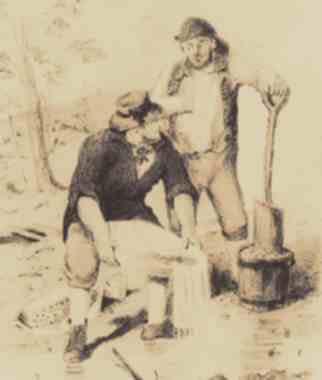
GOLD RUSH OF TASMANIAN
GOLD RUSH TASMANIA
TASMANIAN GOLD RUSH
GOLD RUSH TASMANIA
Gold Rush Tasmania - Gold was believed to have been discovered on the apple isle at Nine Mile Springs (called "The Den", later named Lefroy 1881) in northern Tasmania (N) in the early 1840s by a convict mining prospector prospecting - goldfield mine. Gold Rush Tasmania - Then it is said that John Gardner found gold-bearing quartz in 1847 on Blythe Creek, near Beaconsfield - goldfield mine prospectors . Gold Rush Tasmania - mining prospector prospecting But the first substantiated find was made by a Mr Riva in that area in 1849. Gold Rush prospectors - goldfield mine. Tasmania - mining prospector prospecting. It is said that gold was found at Fingal near Mangana in eastern Tasmanania (E) in 1851 by the "Old Major" who quietly worked the gully for several years - goldfield mine. Gold Rush Tasmania - However, a Major's Gully exists at Mangana. Gold Rush prospectors Tasmania - mining prospector prospecting. The first payable alluvial deposits were reported in 1852 by James Grant at Nook (N). Finds were made at Mangana and Tower Hill Creek (NE). (Debate ensues as to whether Mangana, the Nook and Tullochgoram were one and the same place.) - goldfield mine Gold Rush Tasmania - mining prospector prospecting. mining prospector prospecting. The first registered gold strike was made by Charles Gould - goldfield mine. Gold Rush Tasmania - mining prospector prospecting. It was located at Tullochgoram (E) near Fingal, south of St. Marys and weighed 2lb 6ozs. Gold Rush Tasmania - In 1854 gold came to light at Mt. Mary (SE) - goldfield mine. Gold Rush Tasmania - Tasmania's first reef gold mine was opened by James Grant in 1856 at the Nook (N) - goldfield mine. Gold Rush Tasmania - The discovery attracted 500 miners. Gold Rush Tasmania - mining prospector prospecting prospectors prospectors prospectors prospectors . The first payable reef gold was found at Mangana (NE) and Mathinna in 1858 - goldfield mine. Gold Rush Tasmania - In 1859 new discovery was made by James Smith who came upon it at River Forth (N), and Peter Leete struck it at Calder nor-north western Tasmania (NNW) a tributary of the Inglis - goldfield mine. Gold Rush Tasmania - mining prospector prospecting. the Acheron River a tributary of the Jane River - goldfield mine. Charles Gould obtained gold from Lyndhurst (Waterhouse) (NE) in 1864 and 1869. Gold Rush Tasmania - mining prospector prospecting. At Specimen Hill, Nine Mile Springs (Lefroy) the first alluvial gold was discovered by Samuel Richards in the year I869 (reef gold was actually identified in 1867) - goldfield mine. Gold Rush Tasmania - Production was mainly restricted to the Native Youth, Chum, Volunteer and New Pinafore Reef mines. Gold Rush Tasmania - The news of this brought the first big rush to Nine Mile Springs - goldfield mine. Gold Rush Tasmania prospectors - mining prospector prospecting. A township quickly developed beside the present main road from Bell Bay to Bridport, and dozens of miners pegged out claims there and at nearby Back Creek - goldfield mine. Gold Rush Tasmania - Samuel Richards's Specimen Hill find was alluvial gold. Gold Rush Tasmania - However most of the gold in the Nine Mile Springs area was bonded to quartz below the surface - goldfield mine. Consequently, companies moved in to crush the ore. Gold Rush Tasmania - The Lefroy Goldfield became the first profitable goldfield - goldfield mine. Gold Rush Tasmania - mining prospector prospecting. Gold was initially found at Cabbage Tree Hill (N) in 1870, (later renamed Brandy Creek which became Beaconsfield in 1879) - goldfield mine. Gold Rush Tasmania - mining prospector prospecting. The Denison and Golconda (SW) alluvial deposits were not discovered until 1872, and the reefs were not opened up until 1876 and 1877 respectively - goldfield mine. Gold Rush Tasmania - mining prospector prospecting. Charles Bessel and company also found gold at Tobacco Creek near Golconda Creek in 1877 - goldfield mine. Gold Rush Tasmania - Chinese also panned for gold in 1876 at the Hellyer Cam and Inglis Rivers, and at Doctors Rock (NW) a landmark near Wynyard and Somerset. Gold Rush Tasmania - mining prospector prospecting. The government surveyor, Charles Sprent led his first expedition - goldfield mine. Gold Rush Tasmania - He found alluvial and reef gold in the many creeks running into the Pieman River near Waratah; also in the Whyte and Heazlewood Rivers - goldfield mine. Tasmanian Gold Rush - mining prospector prospecting. Perhaps the most important gold discovery in Tasmania occurred in 1877, when William and David Dally found an auriferous reef of gold at Tasmania reef on the eastern side of Cabbage Tree Hill (N), Beaconsfield Goldfield (N) in the Tamar Valley (Small quantities of gold were found there earlier in 1857) - goldfield mine. Tasmanian Gold Rush prospectors - mining prospector prospecting. Major gold companies moved to the region. Tasmanian Gold Rush - mining prospector prospecting. The crushing of quartz ore began at Mathinna (E) (mine giving 246,000 ozs of gold from 300,000 tons of ore) and Tower Hill near St. Mary - goldfield mine. Gold was found at Lymington near Cygnet. Tasmanian Gold Rush - mining prospector prospecting. Beaconsfield in northern Tasmania commenced organized production in 1877 when Mr. Win. Dally discovered an auriferous reef. Tasmanian prospectors prospectors Gold Rush - In a short space of time, 53 mining companies began operating in the area - goldfield mine. Tasmanian Gold Rush - mining prospector prospecting. This made Beaconsfield the third largest town in Tasmania. Tasmanian Gold Rush - Between 1877 and 1914 Beaconsfield’s Grubb Shaft Mine was by far the largest single source of gold in the state, reaching its peak in gold production around 1900 - goldfield mine. Tasmanian Gold Rush - mining prospector prospecting. Beaconsfield gave 855,000 ozs of gold from 1,023,000 tons of ore. Tasmanian Gold Rush - The west coast was opened up when gold was found by Jack Brown at a place called Brown Plains (W) in 1877 (other sources 1878). Tasmanian Gold Rush - Frank Timbs came upon the mineral in 1878 at a location between Heemskirk and Waratah (NW) - goldfield mine. Tasmanian Gold Rush - mining prospector prospecting. The most productive mine in Tasmania was Lisle Creek at Lisle Goldfield (N), (originally Mt. Arthur Goldfield), discovered by Charles Bessell and his brother in 1879, where more than 250,000 ozs of gold was obtained - goldfield mine prospectors. Within a year, more than 2,500 miners worked the mine. Tasmanian Gold Rush - mining prospector prospecting. Soon creeks on the Whyte, Savage and Donaldson Rivers (NW) were identified as sources for gold - goldfield mine. Tasmanian Gold Rush - mining prospector prospecting. Other locations were at Long Plains (1 km east of Golden Ridge), and in the Savage River area north of Pieman River including Big Duffer Creek on the southern margin of Golden Ridge opened by George Johnson and Ted Peevor - goldfield mine. Tasmanian Gold Rush prospectors - mining prospector prospecting. Extensive alluvial gold deposits, enough for a decent living to about 400 diggers in those days, were found at Middleton Creek in 1879 (NW) by Harry Middleton and company. Tasmanian Gold Rush prospectors - A gold rush ensued when in 1879 diggers came across gold in the Pieman River Goldfield (Corinna Goldfield) from the Meredith Range Donaldson River which included Browns Plains, Nancy Creek, Lucy Creek and Paradise River, all tributaries to the Pieman River south-east of Corinna - goldfield mine. prospector prospecting.
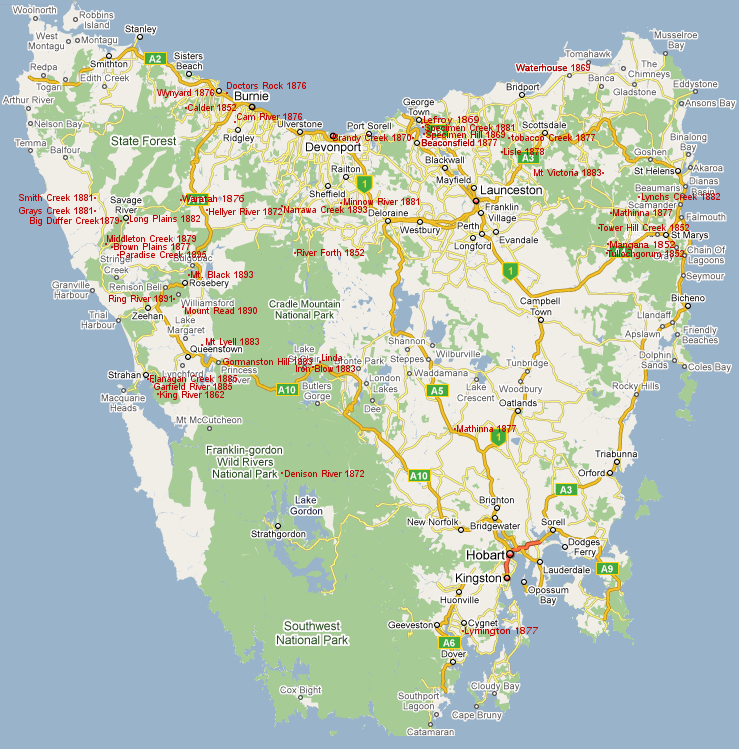
Loading..........





Lefroy (The Den) is where the rush for gold began in Tasmania. The Town is located in north Tasmania. It is quite close to the large city of Launceston, only 40 kilometers away. A road leads from the town to the coast. It is a quiet area with small rolling hills, slopes and valleys. The mines are 60 meters above sea level. The land is drained by many creeks. A find by Samuel Richards at Specimen Hill in 1869 started the rush. Once the Reward Mine was established people flocked to the area. Excavations spread westward. All the easy gold was taken by 1884.
The governor of Tasmania Sir William Denison offered a reward of £5,000 in 1852 for the discovery of payable gold. It is difficult ot ascertain just how much was paid out, though Samuel Richards received a reward of £3000 in 1881 for his discovery of profitable gold on Specimen Hill near Nine Mile Springs in 1869.
When gold was discovered at Beaconsfield, full-blood Tasmanian Aboriginals were in the area. Only a grocery store and drapery shop existed there. All around were snakes and scrub land. But when the Grubb Mine was operating people swarmed to the new town. A hotel, more shops and even dance halls were built for the propectors' amusement. Soon women arrived and the miners started families, but the children were brought up in tents. There were enough people for circuses and professional singers to visit. Beaconsfield on the western side of the Tamar River was the main mining center in Tasmania.
Activity began in earnest again in 1891 with the opening of Pinafore mine by J. T. Stubbs. Work here and at Volunteer mine continued until 1896 when the region was worked out. Lefroy has yielded more gold, reef and alluvial, than Lisle.
Lisle, north of Mt. Arthur, in the north east of Tasmania was the state's third largest goldfield. It was the most productive alluvial goldfield in the state, producing 1o tonnes in all. Conditions were harsh in the early days. Many prospectors still lived in tents. The photograph show a miner's hut. Having a hut was a luxury. But if a miner found a wife he would have to provide this in order to bring up a family.
Charles Sprent the government surveyor led expeditions in search of gold. His team examined the region around Arthur, Pieman, Heazlewood, Rapid, Wedge and Whyte rivers.
He said "As in the case of the Hellyer River so it is with the Pieman River; wherever the softer schists occur gold is found in small quantities, and I have not the slightest doubt that gold will be found in paying quantities, both alluvial and reef gold".
Prospectors had to regularly cross the Arthur River to and from the diggings. The river was cleared by hand in the 1870s for the ferry service, which operated for over 100 years. Food, supplies and cattle were transported across the river.
He said "As in the case of the Hellyer River so it is with the Pieman River; wherever the softer schists occur gold is found in small quantities, and I have not the slightest doubt that gold will be found in paying quantities, both alluvial and reef gold".
Prospectors had to regularly cross the Arthur River to and from the diggings. The river was cleared by hand in the 1870s for the ferry service, which operated for over 100 years. Food, supplies and cattle were transported across the river.
From "The Courier" 3rd March 1852:
A prospector was panning for gold when another gentleman came up to him. The man said "MY DEAR SIR,-The existence of a rich auriferous gold has been made is situated about six miles from this township, at a place called Stanfleld's Nook, but en Valley. The gold was first found by a shepherd in the employment of James Grant, Esq., of Tulloch....The land more to the northward and eastward of Fingal is worth examination, particularly about Mount Arthur and the hills in the vicinity of that mount. Since writing the above, we surface of the ground in the vicinity above alluded to also a few specimens of gold in quartz, found a few miles to the northward of Fingal ....I visited the Tower Hill Diggings, originally called the Tulloch found is on the banks of the Tower Hill Rivulet, I think Tower Hill Diggings would be the most appropriate name. I washed several dishfuls of soil, and found seven or eight particles of gold". (sic)
A prospector was panning for gold when another gentleman came up to him. The man said "MY DEAR SIR,-The existence of a rich auriferous gold has been made is situated about six miles from this township, at a place called Stanfleld's Nook, but en Valley. The gold was first found by a shepherd in the employment of James Grant, Esq., of Tulloch....The land more to the northward and eastward of Fingal is worth examination, particularly about Mount Arthur and the hills in the vicinity of that mount. Since writing the above, we surface of the ground in the vicinity above alluded to also a few specimens of gold in quartz, found a few miles to the northward of Fingal ....I visited the Tower Hill Diggings, originally called the Tulloch found is on the banks of the Tower Hill Rivulet, I think Tower Hill Diggings would be the most appropriate name. I washed several dishfuls of soil, and found seven or eight particles of gold". (sic)












LOCATIONS AND DATES OF GOLD STRIKES
To search for a word on this page = Ctrl+f
Pieman River
Gold Miner's Hut
Beaconsfield
Pinafore Mine
to HOME PAGE for more information.


Histats.com


